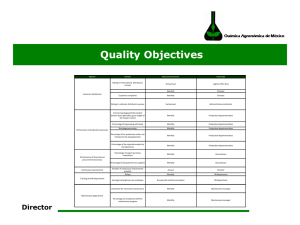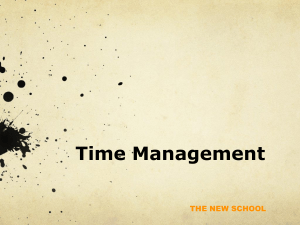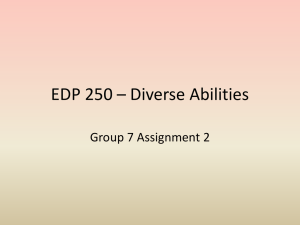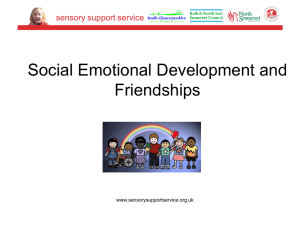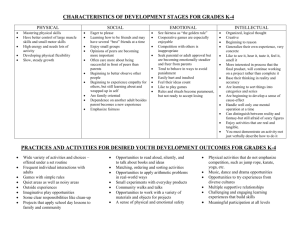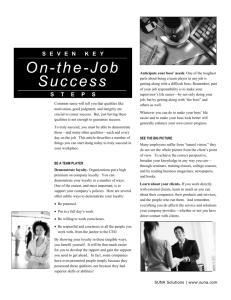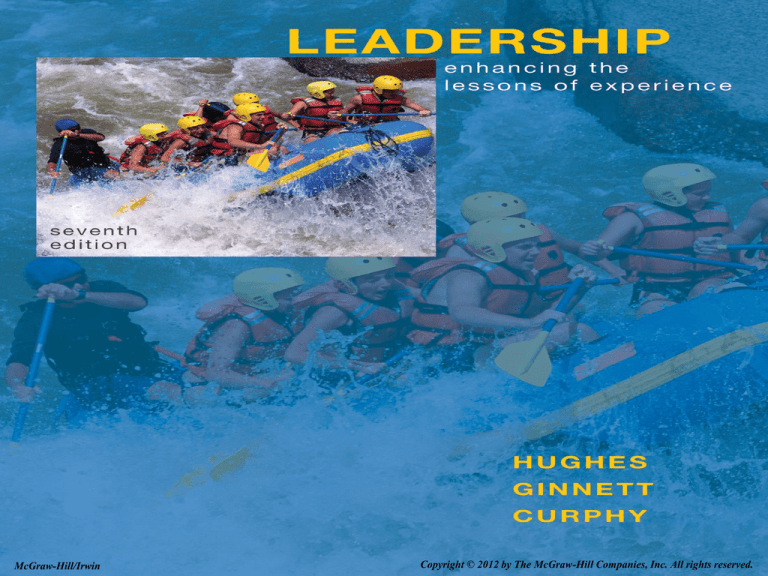
McGraw-Hill/Irwin
3-1
Copyright © 2012 by The McGraw-Hill Companies, Inc. All rights reserved.
Chapter
3
Skills for Developing
Yourself as a Leader
3-2
Introduction
• Your First 90 Days as a Leader
• Learning From Experience
• Building Technical Competence
• Building Effective Relationships with
Superiors
• Building Effective Relationships with Peers
• Development Planning
3-3
Your First 90 Days as a Leader
Figure 3.1: New Leader Onboarding Roadmap
3-4
Before you start…
Candidates should gather as much information
about their potential company as they can. Some
good sources of information include:
• Web sites
• Annual reports
• Press releases
• Marketing literature
• Facebook
• LinkedIn
• Plaxo,
• Other social networking sites to set up informational
interviews with people inside the organization.
3-5
The first day…
Two critical tasks to accomplish on the first day on
the job include meeting the new boss and meeting
the new team.
The first meeting with the boss should happen in the
boss’s office and be about an hour long. Key topics
to discuss include:
• Identifying the team’s key objectives, metrics, and important
projects.
• Understanding the boss’s view of team strengths and
weaknesses.
• Working through meeting schedules and communication
styles.
• Sharing plans for the day and the next several weeks.
3-6
The first two weeks…
The first two weeks should be filled with meeting
with many people both inside and outside the team.
The key objectives for these meetings are:
• Learn as much as possible
• Develop relationships
• Determine future allies.
3-7
Meeting key team members…
Meetings with key team members should provide the
new leader with answers to:
• What is the team member working on?
• What are the team member’s objectives?
• Who are the “stars” a level or two down in the
organization?
• What are the people issues on the team?
• What can the team do better?
• What advice do team members have for the new leader,
and what can the new
• leader do to help team members?
3-8
Meeting with peers…
During meetings with peers, the new leader should
discuss:
• Their peers’ objectives, challenges, team structure, etc.
• Their perspectives on what the new leader’s team does
well and could do better.
• Their perspectives on the new leader’s team members.
• How to best communicate with the boss.
• How issues get raised and decisions made on their boss’s
team.
3-9
The first two months…
During this time period, the leader is gathering
more information, determining the direction, and
finalizing the appropriate structure and staffing for
the team. Tasks to be performed include:
• Gathering benchmarking information
• Meeting with key external customers and
suppliers
• Meeting with the former team leader
3-10
The third month…
The new leader should have developed a vision of
the future. Things to do now include:
• Articulate how the team will win
• Identify the what, why, and how of any needed changes
• Define a clear set of expectations for team members.
The two major events for the third month are to:
• Meet with the entire team
• Meet off-site with direct reports (if the team is large).
3-11
Learning From Experience
Leadership practitioners can enhance the learning
value of experiences by:
• Creating opportunities to get feedback
• Taking a “10 percent stretch”
• Learning from others
• Keeping a journal of daily leadership events
• Having a developmental plan.
3-12
Building Technical Competence
Technical competence - knowledge and repertoire
of behaviors one can utilize to successfully complete
a task. Technical competence is important for a
leader for many reasons including:
• It has been found to be consistently related to managerial
promotion rates.
• Many leaders often spend considerable time training
followers
• It helps to reduce the level of role ambiguity and conflict in
their groups
• It helps leaders stimulate followers to think about problems
and issues in new ways, which in turn has been found to be
strongly related to organizational climate ratings and
followers’ motivation to succeed.
3-13
Building Effective Relationships with
Superiors
To build an effective relationship, the leader should:
• Understand their superior’s world
– Understand their superior’s personal and organizational
objectives
– Realize superiors do not have all the answers and have both
strengths and weaknesses
– Keep them informed about various activities in the work group
or new developments or opportunities in the field
• Adapt to the superior’s style
– Clarify expectations about their role on the team, committee, or
work group
– List major responsibilities and use them to guide discussions
with the superior about other ways to accomplish the task and
relative priorities of the tasks.
– Be honest and dependable
3-14
Building Effective Relationships with
Peers
To build an effective relationship with the leader’s
peers, they should:
• Recognize common interests and goals
• Understand peers’ tasks, problems, and rewards
• Practice a Theory Y attitude
3-15
Development Planning
Developmental planning is the systematic process of
building knowledge and experience or changing
behavior. Peterson and Hicks claim that there are 5
interrelated phases to developmental planning:
• Identifying development needs
• Analyzing data to identify and prioritize
development needs.
• Prioritized development needs are used to create
a focused and achievable development plan
• Periodically plan review, reflecting on learning,
and modifying or updating the plan as appropriate
• Transferring learning to new environments.
3-16
High Impact Development Plan
There are 7 steps to developing a high impact
development plan:
• Step 1: career and development objectives
• Step 2: criteria for success
• Step 3: action steps
• Step 4: whom to involve and reassess dates
• Step 5: stretch assignments
• Step 6: resources
• Step 7: reflect with a partner
3-17



